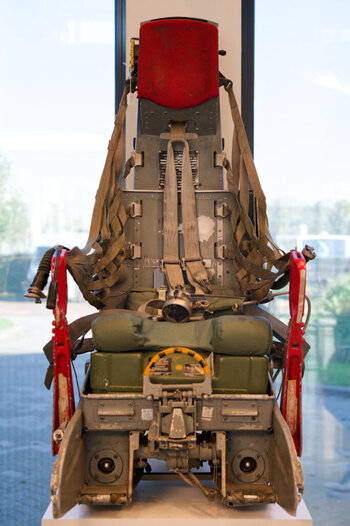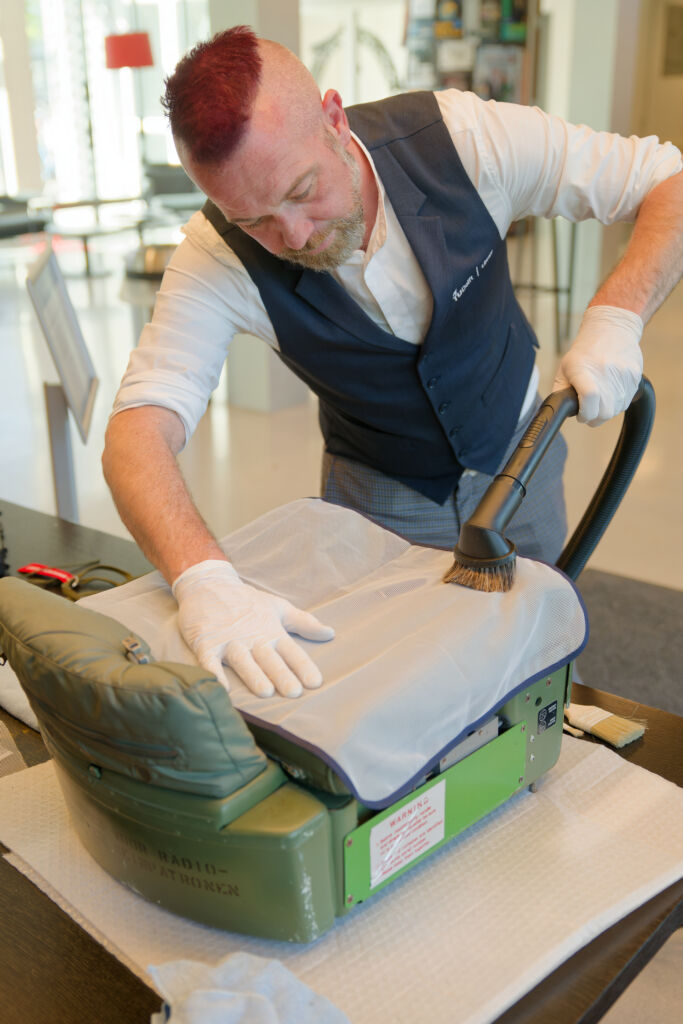Martin Baker C-2 Ejection Seat
When it comes to fighter plane safety, the ejection seat is crucial for ensuring a pilot's survival. This particular seat tells a story of changing purposes without changing the design of a plane, and the need for extra, lifesaving measures. The seat still has all its cushions, gears and belts, and is an interesting sight with a very interesting story. To enhance its visibility, in October 2024 it has been cleaned, stabilized and re-displayed on a plinth and it offers a fascinating glimpse into jet-age technology.
The story of the seat, used in the Lockheed F-104 Starfighter, which nicknamed the 'flying coffin' goes as follows. The Starfighter was an aircraft with immense speed, capable of flying at twice the speed of sound, it is the only aircraft to hold the records for maximum speed and altitude at the same time. However, complications arose when Lockheed Martin changed the intended function from an extremely fast high flying air interceptor into a low flying bomber. This shift dramatically increased the potential for disaster. The modification required the Starfighter to carry additional weight, including extra fuel tanks and nuclear bombs, which altered its flight characteristics. This caused the angle of attack to change without input from the pilot making the aircraft more unstable. In Europe it was planned for the Starfighter to fly at 30 meters from the ground towards a target.
The plane was a very capable aircraft, but making low level manoeuvres was not something that could be achieved in that airframe. In fact, the story of the Starfighter emphasises how the implementation of technology after its design can influence the safety. Having the F-104 fit into a role it was not really designed for played a significant role in the Starfighter being called the ‘aluminium death tube’ while in service in the Royal Canadian Airforce.
The ejection seat featured here is a Martin Baker C-2 ejection seat, an influential piece of engineering in ejection seat design. What is revolutionary about the C-2 is that it was one of the first zero-zero ejection seats, allowing the pilot to eject even at low altitudes or during take-off. Without this seat more pilots' lives could have been at risk. Previous ejection seats required the aircraft to be at a certain altitude to allow a safe release of the pilot. Early designs and one test aircraft of the F-104 had a downward ejection seat, thankfully that idea was left on the drawing room floor. While the Starfighter faced significant challenges, technology in the Starfighter influenced future aircraft designs. For example, the C-2 ejection seat is in the SR-71 Blackbird, and the J 79 engine of the F-104 was refined overtime to become a propulsion system used in various jet aircrafts. Thus, despite its operational issues, the Starfighter's engineering was revolutionary and had lasting effects on aviation technology, particularly through the C-2 ejection seat.
The aircraft finished service and withdrawn from use at Ypenburg in 1984. Used as a ground trainer at TU Delft from 1989, when storage of the whole aircraft was not possible the F-104 moved to Woensdrecht in 2001. The aircraft being scrapped, and the ejection seat removed at Den Dolder and brought back to TU Delft in 2003.
Within the Aerospace faculty, the ejection seat displayed in the Fellowship has attracted considerable interest from both students and staff. It is located at a key location: in front of the desk at the entrance lobby of the Fellowship. The Ejection Seat is in an excellent state, particularly as this item is completely intact and in original condition. Unlike other ejection seats, which often lack components or show significant wear – for instance, the disintegration of the plastic foam headrest – this example of the C-2 ejection seat stands out.


